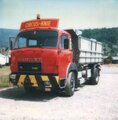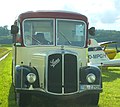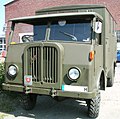Adolph Saurer AG
The Saurer in Arbon on Lake Constance was the most important Swiss manufacturer of medium and heavy trucks and at times of buses and trolley buses and military vehicles .
Today's Saurer AG is one of the largest textile machine manufacturers in the world with a turnover of 1.6 billion euros and almost 9,000 employees. A third of them are active in the second branch of vehicle transmission construction.
The Saurer AG was from the beginning of 2007, a subsidiary of OC Oerlikon Corporation AG in Pfäffikon , is the Chinese Jinsheng Group since 2013 with the business units of natural fibers and textile components.
history
The company was founded by Franz Saurer in 1853 as an iron foundry for household goods in St. Gallen . After moving to Arbon in the canton of Thurgau , the production of embroidery machines began in 1869 . From 1877 onwards, Franz Saurer's brother Hippolyt joined the company as a businessman. Under Adolph Saurer , Saurer developed into the largest sole proprietorship in Switzerland. In 1913 Karl Bleidorn sold the small machine factory he had taken over in Arbon in 1891, which he led to bloom with the production of hand embroidery , threading and re-embroidery machines as well as vane pumps to Adolph Saurer. The share capital of the stock corporation Adolph Saurer Arbon, founded in 1919/20, was 30 million francs.
The workforce at the headquarters in Arbon is a reflection of the success and setbacks of the dominant machine factory in north-eastern Switzerland: the number of employees rose sharply from 1890 (264) to 1920 (2918), fell abruptly in 1922 (908) and recovered by 1936 (1953) ), remained relatively constant from 1937 (2414) to 1950 (2865) and reached the largest number of employees in 1963 (4513). The reason for the relatively constant personnel development since 1937 is likely to have been the overcoming of the global economic crisis , the peace agreement and the federal armaments contracts. The Second World War brought a massive slump in foreign business: of the 3,235 trucks manufactured from 1940 to 1944, only 234 could be sold abroad, 11 of them to Germany.
Passenger cars
This was followed by the production of petroleum- powered internal combustion engines , which were sold to manufacturers of road vehicles from 1896. Probably at Hippolyt's instigation, the manufacture of his own automobiles began in 1897. The first model was a four-seater Doppelphaeton with a single cylinder - opposed piston engine of 6 hp (4.5 kW) in the rear. It was driven by double chains on both rear wheels. The vehicle initially had a steering lever as a control; it was given a steering wheel as early as 1898 . The French manufacturer Société des Automobiles Koch Frères showed interest in this automobile . As early as 1898, a large number of these vehicles were built under license in Paris . Mainly the French army and the colonial administration were customers. At least Koch's version ran on heavy fuel oil .
1902 24/30 PS appeared with the Saurer type a successor with front-built four-cylinder - T-head engine , four-speed transmission and chain drive. This model was further developed into the 30/35 PS type with 5.3 liters displacement , supplemented by the even larger 50/60 PS type with 9.2 liters. Most of these vehicles were bodied by C. & R. Geissberger in Zurich as touring cars or chauffeur-driven limousines .
As early as 1908, Saurer produced a diesel engine on which Rudolf Diesel himself worked. Installation in a vehicle was not yet successful at the time.
commercial vehicles
In 1903 the production of commercial vehicles began , which soon enjoyed an excellent reputation. This success led to the company concentrating entirely on this area after 1914. In addition to trucks , Saurer also manufactured buses, which were widely used throughout Switzerland. In the First World War Saurer also built aircraft engines.
In a relatively short time, Saurer advanced to a world-renowned vehicle manufacturer due to various innovations and Saurer trucks were also manufactured under license in some countries : In Austria ( Österreichische Saurerwerke ), France (Saurer France), Yugoslavia ( FAP ), Great Britain ( Armstrong Saurer ) and the USA ( Saurer Motor Company ). The US operation merged with the Mack Brothers Company in 1911 .
Saurer awarded numerous licenses for the manufacture of diesel engines, for example in the 1920s to the since the 1960s for Fiat - group belonging to the Italian car manufacturer OM in Milan .
In 1928 the first really usable diesel truck appeared on the market, for which Saurer initially relied on the acro air storage method according to Herbert Akroyd Stuart (1864–1927) and developed it further until 1934 to the Saurer cross- flow method for direct fuel injection, supplemented by a special swirling system Combustion air. Saurer received a patent for this in 1936.
In 1929, Saurer became a majority partner in Berna , the second large commercial vehicle manufacturer in Switzerland, with the two brands offering largely identical vehicles from the 1970s onwards, which could only be distinguished by their names. During this time, Saurer was one of the world leaders in the development of diesel engines and remained so until well into the 1980s. The first Saurer fire engines were also built in the 1920s .
From the 1930s onwards, Saurer was the most important manufacturer of medium-sized and heavy trucks in Switzerland, so that these were still present in all possible variants on Swiss streets until the 1990s. During the Second World War , in which Switzerland remained neutral and was therefore not involved, Saurer built numerous military vehicles for the Swiss army .
In the immediate postwar period, in 1947, built Saurer in small numbers is also a liquid-cooled V12 - aircraft engine with standing cylinder type Saurer YS 3 , which for at the Swiss Dornier works in Altenrhein developed fighter bomber Dornier D-3803 was determined. However, since there were problems with the new aircraft (a parallel development to the Dornier D 3802 , in turn derived from the French Morane-Saulnier MS406 ), it was not developed to series production and the aero engine production, which was still in the making, ended again.
In the meantime, the export business with trucks and buses, which was still successful in the 1950s, declined, so that the company also began manufacturing diesel engines for railcars and ships and, in the commercial vehicle sector, geared itself even more towards the Swiss market. From the 1960s onwards, Saurer trucks with a particularly high payload for the Swiss market often had drive formulas that are still in use today (similar to contemporary trucks of other origins) , such as 8 × 4 with two steered front axles . Saurer also carried out development work in the construction of chassis, eight-speed and preselector transmissions and fluid couplings.
Semi- trailer tractors remained rare, but buses such as the Saurer 3DUK-50 and trucks for the Swiss Army continued to be produced. Trolleybuses became a further mainstay and Saurer also invested in the development of an articulated version.
In 1982, Saurer was merged with Franz Brozincevic & Cie Wetzikon (FBW) to form the Arbon & Wetzikon (NAW) commercial vehicle company, Daimler-Benz held a 40% stake after the German company had previously taken over FBW. From the beginning of the 1980s, some light truck types from Daimler-Benz were also manufactured and marketed as Saurer in Arbon, but the demand for original Saurer vehicles continued to decline despite the still recognized good quality, so the decision was made to get out of the construction of commercial vehicles.
The last civilian Saurer was delivered in 1983, and in 1987 the Swiss Army received the last " 10DM ". Saurer's engine research department was taken over by the Italian truck manufacturer Iveco, which belongs to the Fiat group , around 1990 . After that, a few more buses were manufactured under the brand name NAW until this company was dissolved in 2002. In 1990 Saurer took over Melco Industries .
restructuring
Since the 1990s, Saurer, as the new Saurer AG, has been concentrating on the construction of textile machines and has advanced to become one of the world's largest manufacturers with sales of 1.6 billion euros and almost 9,000 employees. A third of them are active in the second division of vehicle transmission construction, which was added later .
From the beginning of 2007, Saurer AG was a subsidiary of OC Oerlikon Corporation AG from Pfäffikon . On December 3, 2012, the OC Oerlikon Group sold its natural fibers and textile components business units to the Chinese Jinsheng Group for around 650 million francs. The takeover also includes the Swiss locations of the traditional textile machinery company Saurer in Arbon and Wattwil with around 180 employees. Worldwide 3800 jobs come under the Jinsheng Group. At Oerlikon, only the Barmag man-made fiber business remained in Germany.
Picture gallery
Saurer trucks
Saurer buses
Public bus in Altstätten Bahnhof-Stadt (1984)
Saurer trolleybuses
Articulated trolleybus Saurer GT 560 / 640-25 with three-phase drive in Winterthur 2005
Saurer military vehicles
Saurer MH4 4 × 4
(artillery towing vehicle from 1954)Saurer 2DM 4 × 4
(medium truck from 1964)Saurer 10DM 6 × 6
(heavy truck)Saurer Tartaruga infantry fighting vehicle (turtle)
See also
literature
- Kurt Sahli: Saurer. History of a commercial vehicle factory . Stämpfli-Verlag, Bern 1987, ISBN 3-7272-9625-9 .
- Stefan Keller : The time of the factories. Of workers and a red city . Rotpunktverlag, Zurich 2001, ISBN 3-85869-228-X .
- Hans Ulrich Wipf, Mario König , Adrian Knoepfli: Saurer. From a small business in Eastern Switzerland to an international technology group. hier + now, publishing house for culture and history, Baden 2003, ISBN 3-906419-55-X .
- Markus Mäder: Three generations of Saurer. Franz Saurer (1806–1882), Adolph Saurer (1841–1920), Hippolyt Saurer (1878–1936). (Swiss pioneers in business and technology, Volume 48). Association for economic history studies, Meilen 1988, DNB 901454850 .
- Harald H. Linz, Halwart Schrader: The great automobile encyclopedia. 100 years of history. 2500 brands from 65 countries. 2nd edition, BLV Buchverlag Munich / Vienna / Zurich 1992, ISBN 3-405-12974-5 .
- George Nick Georgano (Ed.): Complete Encyclopedia of Motorcars, 1885 to the Present. 2nd Edition. Dutton Press, New York 1973, ISBN 0-525-08351-0 . (English)
- Arthur Logoz, Martin Wiesmann: Oldtimers. (Gloria, 11). Gloria Publishing House. Bergdietikon (Switzerland) 1970, DNB 1017071381 .
- Hans Geisser: Shadows over the city by the lake. Everyday life in Arbon in crisis and war 1930–1945 . Ed .: Museumsgesellschaft Arbon, Arbon 2010, ISBN 978-3-9523381-3-1 .
- Hundred years of work on technical progress - thoughts on the anniversary of the AG. Adolph Saurer . In: Automobiltechnische Zeitschrift . 9/1953, pp. 243-246.
Web links
- Saurer AG
- Sour club
- Oldtimer Club Saurer
- St. Galler Tagblatt from July 26, 2011: Saurer empire with roots in St. Georgen
Individual evidence
- ↑ a b Announcement of the sale of Saurer AG to the Jinsheng Group
- ↑ Sales notification to the Chinese Jinsheng Group ( Memento from June 12, 2016 in the Internet Archive )
- ↑ Hans Geisser: Shadows over the city on the lake. Everyday life in Arbon in crisis and war 1930–1945
- ↑ Logoz, Wiesmann: Oldtimers. 1970, p. 100.
- ↑ a b c d Georgano: Complete Encyclopedia (1973), p. 611.
- ^ Georgano: Complete Encyclopedia (1973), p. 406.
- ↑ Logoz, Wiesmann: Oldtimers. 1970, pp. 101/102.
- ↑ Chronology Saurer ( Memento from February 14, 2016 in the Internet Archive ) Oldtimer Club Saurer (see year 1908).
- ↑ a b c d e Logoz, Wiesmann: Oldtimers. 1970, p. 102.
- ^ Franz Betschon and Walter Knecht: From the small foundry to the global corporation and back. In: Franz Betschon, Stefan Betschon, Willy Schlachter (eds.): Engineers build Switzerland. First-hand history of technology. Volume 2. Verlag Neue Zürcher Zeitung, Zurich 2014, ISBN 978-3-03823-912-3 , pp. 75–94.
- ↑ Internet site of the Chinese Jinsheng group


































